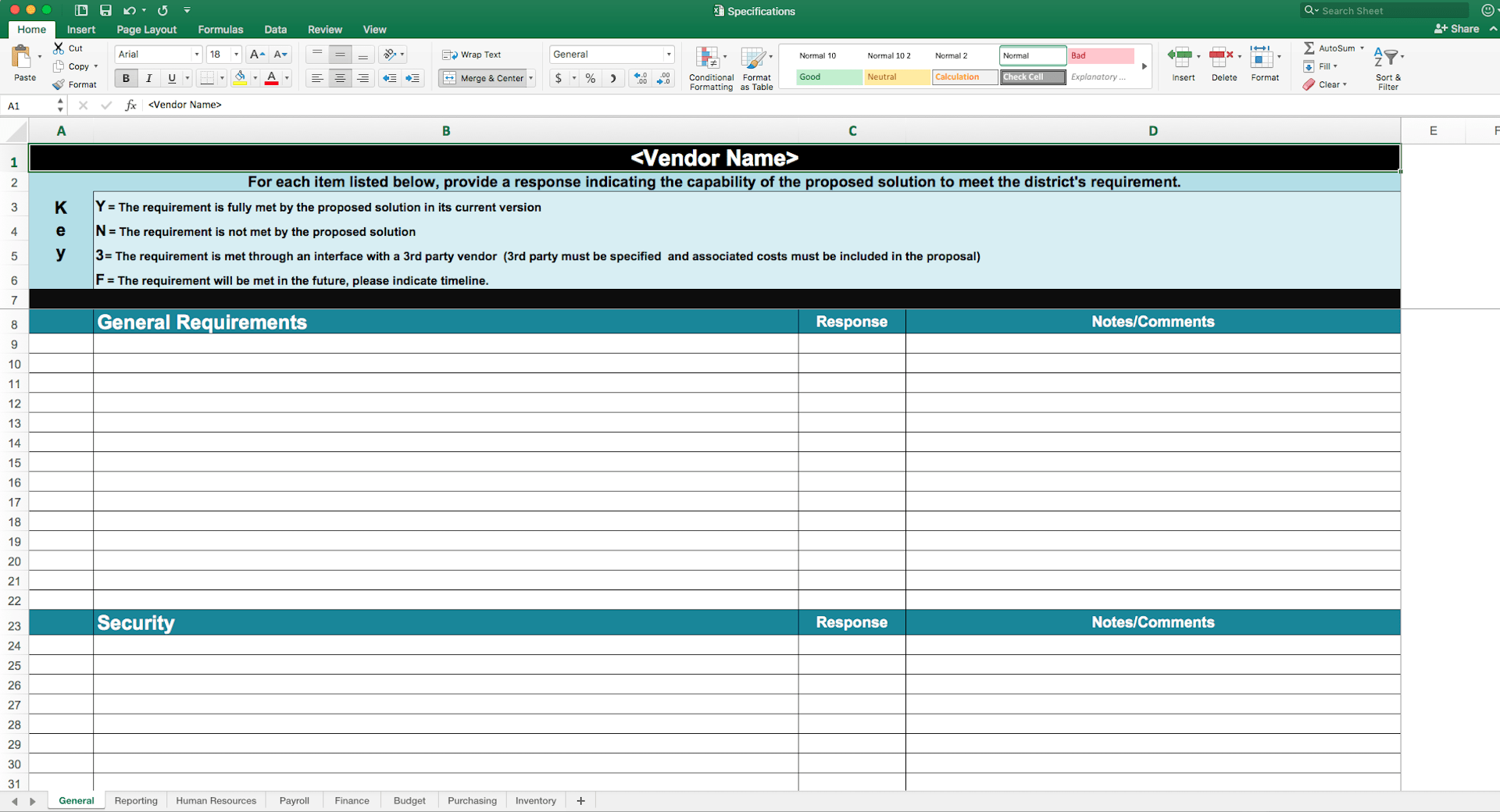
In an ideal world, edtech RFPs would accomplish two goals:
- Provide an impartial, transparent framework to combat corruption and filter preexisting bias out of decision making.
- Enable district evaluation teams to rigorously vet all options and make the best choice for their staff, students, and communities.
These are important and noble pursuits in theory, but things don’t always play out as intended. Based on my review of more than 200 SIS and ERP RFPs, and the knowledge of how most of them turned out, here are five simple steps you can take to get better results the next time you go out to bid.
1) Own Your Template
Due to the vast scope of most enterprise technology RFPs, it’s a common practice for districts to “borrow” templates from peers, neighbors, and anyone else who might have one available. More than half of all the bids I reviewed were direct copies or variations of a template used by at least one other district within the sample.There’s nothing inherently wrong with this practice. It’s a bit much to ask districts to reinvent the wheel when others have been through this process before them. Even so, if you want to end up with the best solution for your district, it’s important to take the time to tailor the RFP to your specific needs.
Avoid: Trusting in any template without a thorough vetting. In my research, I came across one 2014 bid that included a requirement for the SIS to export to microfiche and another one with references to airplane parts. Old templates (or those from another industry) will set you up for poor results.
Instead: Work with key stakeholder groups to align requirements, specifications, and the response outline with your district’s mission. This will take more time up front, but the ultimate goal is to settle on the best partnership for you, and that means a more personalized RFP.
2) Scout Your Consultants
There are two reasons why a consultant might be brought in to run the RFP:- A district does not have the expertise or bandwidth to manage a thorough RFP process.
- A district wants the added layer of impartiality that a third party can bring to the table.
Although more common in very large districts with million dollar-plus contracts on the line, I came across consultants in a number of smaller bids as well. While some consultants are closely attuned to the needs of modern school districts, others require a more cautious approach.
Avoid: Taking a consultant’s impartiality or experience for granted. In one case, I reviewed five bids managed by a consulting group. In all five cases, the bid was won by the same small, regional vendor. That vendor won less than 25% of all other bids it was involved in. Maybe the pattern was a coincidence, but it seems unlikely.
Instead: Ask potential consultants to provide the results from their 10-20 most recent similar projects, then call those districts and ask them how happy they are with their decisions. Many consultants have also been working off the same templates for years – work closely with the company you choose to ensure the same personalization mentioned in the last section.
3) Consider a More Modern Approach to Training
Training is a staple of the enterprise software RFP, and for good reason. If your staff doesn’t know how to use the system or they feel intimidated and underprepared when the launch date rolls around, your entire implementation falls apart. The one factor that contributes to edtech success more than any other is the comfort level of the people who are asked to use the technology.Avoid: Getting caught up in the traditional way of doing things. The overwhelming majority of RFPs I reviewed emphatically underscored a requirement like this one:
“All end-user and technical training will be performed on-site through implementation and be delivered by the Vendor.”
But why? Despite years of research telling us that direct, lecture-style instruction is one of the least effective pedagogical approaches, that’s still how most edtech training is delivered. Even as our classrooms become ever more blended, employee training remains largely unchanged.
Instead: Focus on the end goal of where you want your staff’s knowledge level to be when you go live, instead of how you want them to get there. Consider recalibrating the training section of your RFP to require a more detailed, continuous professional development model from all potential vendors.
For many years, vendors tried to shift the onus of responsibility for training and development to the district. That’s not an acceptable model anymore. We’re not far from the day when digital badging will be a basic expectation for any major technology provider.
4) Rethink Your Support Questions
Of all the traditional headings/sections of the RFP, support was the most consistent throughout my review. Requirements included items like:- What is your average response and resolution time?
- What is the average experience of your customer support representatives?
- What is the typical workflow of a support ticket?
These are good questions, but aren’t they based on an outdated notion of what support should look like? When I use technology for work (which I do, every day), I consider it a poor experience if I have to contact support even once. Online, self-service help resources aren’t just the future of support, they’re the now. Even so, further discovery remains surprisingly absent from RFPs.
Avoid: Thinking of support as “what happens after I pick up the phone.” Response and resolution times were critical back when the only way to get help was to contact the vendor. It’s fair now to demand more options and better resources for your employees. If someone is having trouble figuring out a process, would you rather they call and wait for the vendor to respond or press a button and be presented with information that can help them resolve the problem on the spot?
Instead: Use the RFP to uncover the modern version of support – online help resources. Does the vendor make it easy for users to find context-sensitive, multimedia resources to guide them through whatever problems they may encounter? Are these resources presented in such a way that you don’t have to go digging through them? Are they accessible through the system itself or will users bounce around to different places to find them? Preemptive support can’t be uncovered with traditional metrics, but it can be evaluated with just a few extra lines in your RFP requirements.
5) Make UX a Priority
Now that we understand how vital the concept of user experience is in everything from initial buy-in to long-term productivity and results, it might be time to get innovative about evaluating UX. The RFP is still very much a functionality measuring stick, but that’s only a fraction of the overall experience. Yes, you’ll be inviting vendors in for demonstrations, but can the RFP itself evolve to better capture the metrics that matter?Perhaps my consistent proximity to the world of digital media is affecting my judgment, but isn’t it reasonable to ask why we’re still evaluating technology based on checkmarks made on a PDF printout?
Avoid: Boxing yourself into a text-driven evaluation. In my evaluation, it was common to find narrative requirements interspersed with checkboxes. In some cases, districts relied almost entirely on narrative response. This is certainly more descriptive than the black and white, yes/no approach, but it still felt lacking in substance or context based on what I know is possible.
Instead: Consider incorporating visual media into your response requirements. If you want to know how easy it is to take attendance in an SIS, what’s more valuable: a 30-second screen capture or a two-paragraph narrative? When reviewing ERP options, would you rather compare vendor responses to a series of yes/no specifications or watch a side-by-side representation of everyday tasks (paying an invoice, for example)? Words can’t capture the critical elements of “look” and “feel.” Next time you go out to bid, consider a multimedia approach.
The RFP isn't necessarily a broken process; it’s just outdated. Because there is no official governing body or set of standards, there is nobody accountable for moving the process forward. The benefit, of course, is that you have the freedom to do what’s best for your school or district. If that means breaking new ground and setting the tone for all those who come after, isn't it worth the results? There are millions of dollars at stake, to say nothing of the trust your team and your community have placed in you.
The education community has always evolved on the backs of risk-takers and innovators. Why should edtech purchasing be any different?
WHAT'S NEXT FOR YOUR EDTECH? The right combo of tools & support retains staff and serves students better. We'd love to help. Visit skyward.com/get-started to learn more.

|
Advancing K12 Staff Edtech Thought Leaders |




